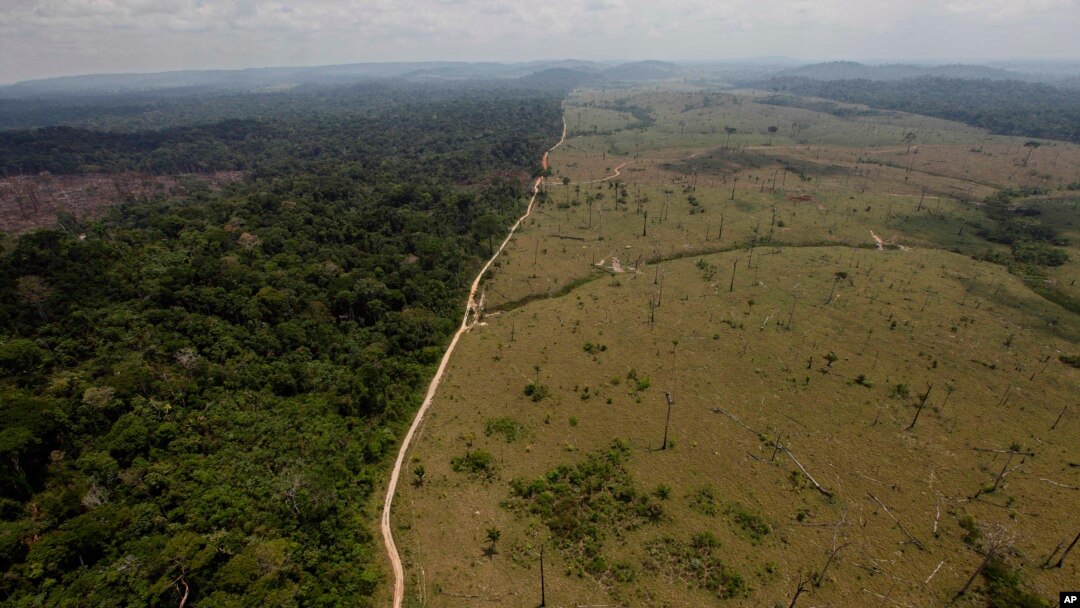Protecting the world’s forests is promoted as a way of reducing greenhouse gas emissions. Forests store a lot of carbon in both trees and soil, which helps mitigate climate change. But some researchers say conserving forests alone will not significantly reduce emissions.
Your browser doesn’t support HTML5
Listen to De Capua report on forests and climate change
It’s estimated that protecting forests could prevent 77 billion tons of carbon dioxide from entering the atmosphere by the year 2100.
Researcher Alexander Popp said that “protecting forests to abate climate change is definitely worthwhile.”
“Avoiding deforestation, in general, is a very important aspect, first of all, in terms of carbon emissions avoidance, but also from other perspectives like biodiversity conservation, local livelihoods or local climate aspects,” he said.
Popp, group leader on land use management at the Potsdam Institute for Climate Impact Research, said while preventing deforestation does have beneficial effects, there can be consequences if that’s all that’s done.
“Indeed, emissions are reduced, but what we could observe is that there are now new emissions occurring from a kind of leakage effect, displacement effect,” he said.
In other words, preserving forests means other types of land would be used to grow crops instead. Popp said that would result in environmental losses.
“Loss of non-forest ecosystems that also have a high carbon content in the soil, in the vegetation, like wetlands savannahs, for example, in Africa or grasslands, and also have a high biodiversity content,” he said.
High biodiversity content means lots of plant and animal species.
Current climate change negotiations include something called REDD or Reduced Emissions from Deforestation and Degradation. But Popp says it only focuses on protecting forests.
“The largest benefits for climate change mitigation could be achieved by…a forest conservation scheme and the inclusion of other land types with high carbon content,” he said. “We did big computer simulations and we looked at three different potential future land use rules: one scenario without any carbon conservation; one with avoiding deforestation only; and one with conservation of all land use types that have high carbon content.”
The all inclusive model yielded the greatest carbon benefits and protected biodiversity. But if a wide variety of land is protected how does agricultural production increase to feed a rapidly growing global population?
Popp said one way is to boost yields on existing farmland.
“In sub-Saharan Africa, there’s much more potential for agricultural yields that we currently observe and therefore much more potential for agricultural production," he said. "If these potential yields could be catched-up (sic) compared to the current yields we observe today – and improve smallholder farm management – it would be an added value in terms of taking the pressure from the land and therefore decreasing agricultural expansion.”
Another way to meet future food needs, he says, is by reducing waste in agricultural production. Much food is lost through poor harvesting methods and lack of proper storage and transportation. Also, studies have shown billions of dollars worth of food is wasted every year in developed countries.
For example, the Natural Resources Defense Council has estimated that “40 percent of food in the United States goes uneaten…the equivalent of $165 billion a year.” It says the food then rots in landfills adding another greenhouse gas to the atmosphere – methane. Livestock production in developed countries, he says, also uses a lot of resources. It also produces a lot of methane.
Popp said that if demand for agricultural commodities is reduced by cutting waste and making agriculture more efficient, there would be less demand for land use.
“By decreasing the production levels that are needed from the land there automatically would be a decrease in the pressure on the land – and therefore less expansion of agricultural production into unused land, like forest or other natural land would happen,” he said.
Given the lack of progress made in climate change negotiations, Popp and his colleagues doubt their comprehensive approach will be adopted now. They said that “a more achievable approach” may be to protect non-forest areas that can store a lot of carbon and have good biodiversity. The REDD plan, they said, would have to be altered so funds can go to programs not related to forests.
The next climate change conference takes place in Lima, Peru. Known as COP 20 – or conference of parties – the meeting runs from December 1-12.


